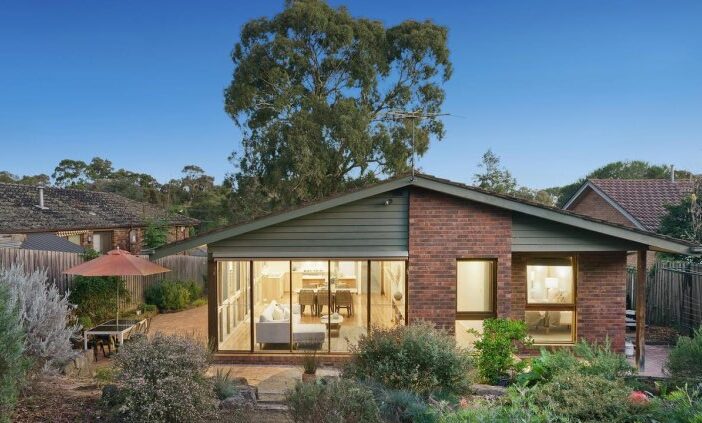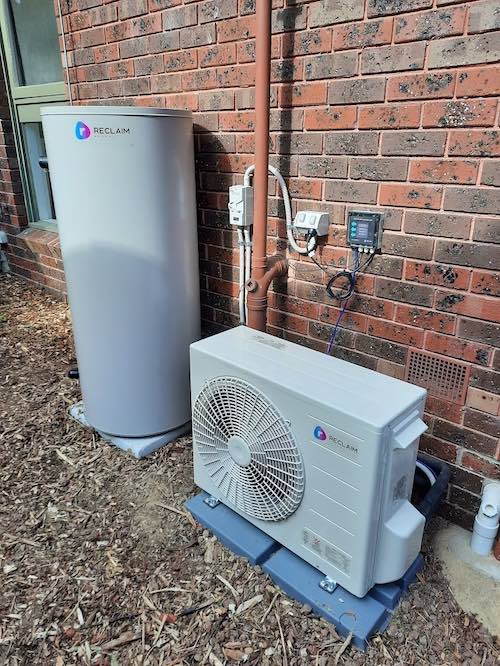
When I moved into my house 2021, in the midst of on-again-off-again Covid lockdowns, my aspiration of getting off gas entirely and having a fully electrified home was just that, an aspiration.
A few short weeks after moving into our early 80s house in the bushy north-eastern suburbs of Melbourne, our hot water service kicked-the-bucket. The initial frustration at having to replace an appliance so soon after moving-in quickly changed to a feeling of opportunity as I realised that I could turf the old, highly inefficient, gas storage hot water service for something far more smart and efficient.
After thorough research into the options and probably too many pestering phone calls to friends in the industry I had a new super, efficient Reclaim Energy heat-pump hot water system installed by RACV Solar.

The ravenous research into efficient solutions for residential hot water led me to understand how one of the fundamental steps to more sustainable living (and cheaper energy bills) is to ‘electrify everything’ (i.e get off gas).
This topic has been championed by Saul Griffith through his book The Big Switch: Australia’s Electric Future and the organisation he has co-founded, Rewiring Australia.
As fortune (or misfortune) would have it, not long after the untimely death of my gas hot water system, and in the depths of a Melbourne winter, my cold-war-era gas ducted heating system spluttered out its last breath of hot air.
Once again I dived head-long into how I could replace this gas-fueled relic with a greener, cleaner, cheaper to run, solution. The sticking point for this choice was that installing a smart, efficient, electric cooling and heating system was going to cost four times the price of replacing a like-for-like gas system (Ouch!)
It was a tough call but I’d already started my journey to a fully electric home so I bit the bullet and installed a Toshiba inverter ducted air conditioning system.
This just left our cooktop as the final gas appliance in our home. As someone who loves cooking I had been convinced that ‘cooking-with-gas’ was the best option and that electric stoves were slow, inefficient, and expensive…this was until a good friend had a state-of-the-art Bosch induction cooktop installed.
The way modern induction cooktops work seems almost magical. Fast, safe, easy to clean and the sleek black glass finish makes it seem like you have a modern, flat screen TV installed on your kitchen bench rather than a stove.
The clincher was that there is a growing amount of evidence to suggest that gas stoves release potentially harmful emissions into your home as covered in this article from The Conversation.
Removing the stove now meant a fully electrified home! MISSION ACCOMPLISHED….right!? Nope, at the front of my house staring back at me was my final foe: the gas meter. For me to be fully electric (and stop paying the daily gas supply charge) it had to be removed. Unsurprisingly the process to have the gas meter removed was significantly more complex, arduous and confusing than it should be.
In industry speak, the process for removing your gas meter is called “meter abolishment.” In most cases, contacting your gas retailer is the first step in getting your gas meter removed. The more helpful retailers have a request form on their website.
Considering the daily supply charge for gas is usually about $1 per day you must decide for yourself whether it makes sense to remove your meter. For example, if it costs $500 to remove your meter then it’s going to take around 500 days before you are ahead.
I am now looking at having my very old, very small solar system replaced and after years of scouring The Driven I have just ordered my first EV, a BYD Atto 3 which I’m expecting to receive in a few months. This will replace our current family car – a large diesel guzzling SUV.
Final thoughts…
The journey to electrifying my home has been more challenging and more expensive than I expected. I’ve written this article to hopefully provide some assistance to others who are looking to go down this path.
As an increasing number of people go through the process to get off gas, and potentially upgrade their electricity connection, I can only hope that energy distributors and retailers make these processes more user-friendly and affordable, as even with my industry knowledge and contacts it was a minefield of complexity, handballing, run-arounds and countless phone calls and emails.
7 tips for electrifying your home
1. Safety first ALWAYS
If working in the energy sector at places like AusNet Services taught me anything it’s that the safety of you, your family and your household is paramount when it comes to electricity (and gas).
Resist the urge to re-wire or install things yourself – trying to save a couple of hundred bucks is not worth the risk of frying your snazzy new appliance, fire, nasty electric shock, or possibly even death.
Always use a licensed electrician and demand a certificate of electrical safety for all works completed.
2. Research, research, research
There is an endless amount of information out there. Read everything you can but set your BS radar to hyper-sensitive.
3. You get what you pay for
The old adage persists: If the price sounds too good to be true then you’re likely getting garbage. From a cost and sustainability perspective you want appliances that will last the journey …as well as the after-sales service and warranties to match.
4. If it ain’t broke… don’t replace it
In most cases it is not advisable to replace existing appliances until they come to the end of their useful life. Getting a fancy new smart hot water service may sound appealing but replacing your perfectly good gas one is likely a waste of money and materials. The most sustainable thing to buy is nothing at all.
5. Rebate$
There are many different rebates available at state and federal levels for making your house more sustainable including for solar systems, batteries, EVs, air-conditioning and much more. Good installers and retailers should be able to assist you with getting you everything you are eligible for.
Solar Victoria is a great place to start if you are from Victoria.
6. More power?
When many older homes were built there was no expectation that our demand for energy would grow so significantly and the demand that did exist was shared between gas and electricity. My relatively large home only had a 63amp connection, which is very small by today’s standard. Fully electrifying my home meant I needed a larger supply.
I upgraded to 3-phase, which was a complex and expensive process but is future proof and means I can one-day get a very fast charger for an electric vehicle.
7. Find the best energy retailer for you
Gas and electricity retailers’ pricing can vary significantly and their pricing structures sometimes make it difficult to compare apples with apples.
Your situation – including usage behaviours and whether or not you have solar panels – will also impact what is the best deal for you.
There are various different comparison sites which can help you make the right choice.
The Victorian government has Victorian Energy Compare, a specific tool to help you find the best deal.
Bonus tip!
Grab yourself a real-time energy monitoring device like a Powerpal. These devices show you how much electricity you are using in real time as well as providing other energy saving tips. Best of all they are free if you are in Victoria!
Rob Asselman is a marketing and communications professional with over 12 years’ experience in the energy sector including working with innovative startups and ASX100 enterprises.
He was recently selected as the new head of marketing at Chargefox – Australia’s largest EV charging network.



